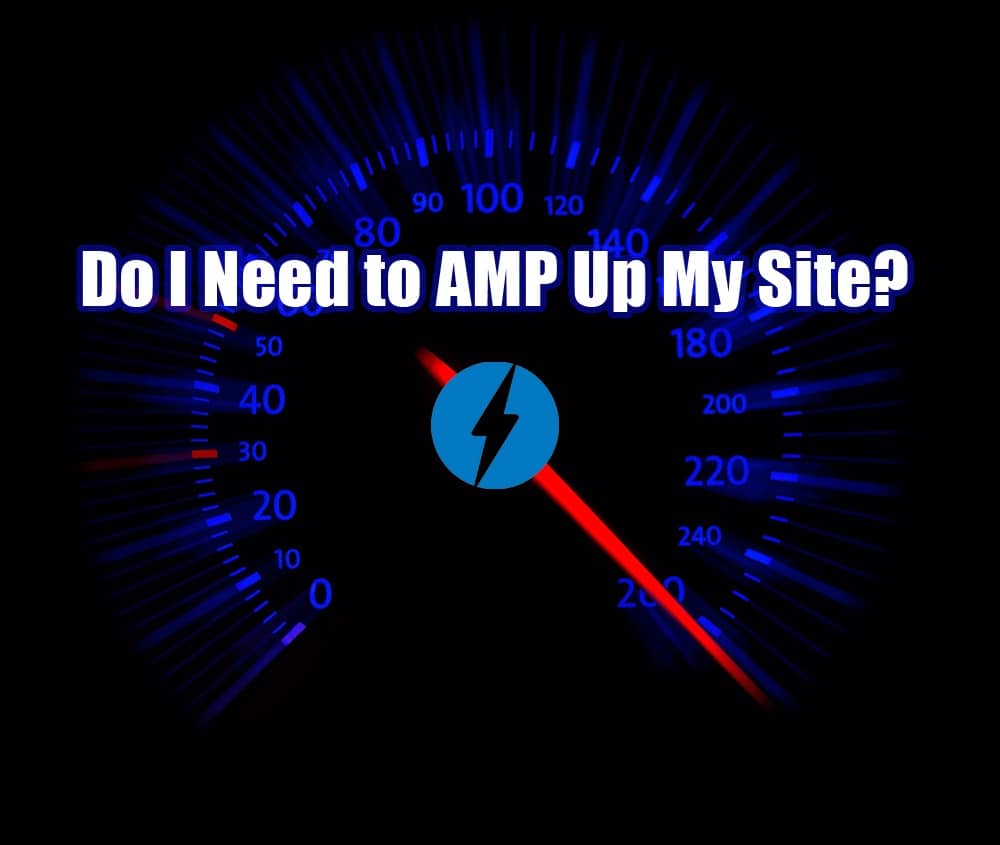
Do I Need to AMP Up My Site?


It’s been over a year since Google unveiled it’s Accelerated Mobile Pages project, encouraging publishers to utilize its free, open-source framework to optimize their pages for greater speed and better UX on mobile devices. So far several hundred million pages have been converted to AMP, but the jury is still out on whether the pros outweigh the cons. Should you AMP up your site?
Pros: Lightning Speed, Better UX
The biggest benefit of an AMP website is its lightning-fast loading speed. In fact, users can identify an AMP site by the lightning icon that appears next to it on a SERP, as in the second listing below.

Savvy searchers know that this icon could save them valuable seconds waiting for a site to load, and savvy publishers know that those seconds matter. In fact, if your page takes more than three seconds to load, over half of mobile users will abandon it before they even get a chance to see what you have to offer. That kind of fickle clicking makes your bounce rate skyrocket and your SERP rankings plummet, especially since mobile is now the primary mode for accessing websites; mobile users accounted for 51.3 percent of internet usage worldwide in October 2016, and users on-the-go demand instant access to information. When combined with SEO content writing, AMP can push your page to the top of the search engine list.
So how does it work? AMP improves your load speed in two ways.
Cutting the Fat
While AMP pages do support rich content such as PDFs, infographics, videos and audio files, they are stripped of unnecessary content that slows load speed, distracts from content and reduces user experience. The result is pages that load in seconds and are easier to navigate on a mobile device.
Cache-ing In on Cached Pages
AMP pages are cached and retrieved from the cloud, reducing the load on your servers and allowing for quicker retrieval time.
By eliminating unnecessary elements, AMPs also made it easier for users to view and navigate your page on the smaller mobile screen. Mobile versions may also streamline buttons for sharing, bringing you even more customers.
News outlets were the first to embrace AMP, but WordPress, Bing, Reddit, Pinterest and eBay are also major participants. What kind of results have early adopters seen?
- Washington Post – Mobile users who return within 7 days increased by 23%.
- Herald – Mobile users spend 10 percent more time on AMP articles than regular mobile pages.
- Slate – 44 percent more unique monthly visitors.
- Wired – Increase of 63 percent CTR on ads in AMP stories
While these preliminary results are promising, there are a number of reasons AMP may not be for you – at least not yet.
Cons: Slower Ads, Codes and Caches
The same factors that make AMP sites fast and easy can also make them less appealing to publishers. AMPs prioritize user experience, which may or may not lead to improved CTRs. They also require changes in tagging, coding and analyzing a page. These drawbacks are the most-cited reasons for not jumping on the AMP bandwagon.
Diminished Ad Revenue
The AMP Project supports ads, but they may take much longer to load than the page itself. By the time an ad becomes visible the user may have scrolled past it, hurting your CTRs. Last year Google announced AMP for Ads, a program that will enable advertisements to load with the same speed as AMP pages. However, until the program is available to all advertisers, publishers may continue to miss out on some ad revenue. On the other hand, one study found that 90 percent of publishers found greater click-through rates for ads on AMP pages than for non-AMP pages.
Cache
When a user clicks on an AMP page, they are taken to a cached version of the page that is stored on Google’s servers instead of your own. While this reduces the strain on your servers, it also means that users see a Google URL instead of your site. Some publishers worry that this cache places their page on a server outside of their control and prefer to preserve the link to their original site.
Additional Coding Required
To create an AMP version a different tag and a separate line of code must be imbedded on every AMP page. Some websites can use the AMP Plugin, but for many the codes and tags must be added manually, page by page. These additions are easy to install, but it does increase the time required to create pages, and some users may choose to convert only high-priority content such as landing pages.
Diminished Analytics
AMPs also require a different analytics tag that must be placed on every page. While AMP supports Google Analytics, the results may be somewhat stripped down, so if you need detailed charts and tables, the data provided by your AMP pages may be disappointing. The limited analytics can be restrictive and insufficient for some users. And again, adding tags and codes to every page takes time. For sites with a lot of content, this conversion can be time-intensive as well as costly.
Will AMP Increase My Traffic?
Google is quick to note that AMP is not currently a ranking signal. Any effect that AMP has on SERP rankings is indirect – faster loading times and more streamlined UX can increase clicks and the time a user spends on the page, improving the page’s rank. Current indexes use desktop pages to determine a page’s rank. However, Google has recently announced that it is testing a mobile-first index that will give preference to mobile-friendly pages. If this becomes the standard, it may be beneficial to convert at least high priority pages to AMP. (Want to see how mobile-friendly your site is? Plug it in here.)
Of course, the most important SERP rank factor is the quality of the content on a page. A pleasing user interface that loads in seconds will not generate clicks or revenue if the content is vague, poorly worded, inaccurate, boring or otherwise useless. Online content writing services can provide content that is thoroughly researched and professionally written, creating the kind of value that your customers are looking for and that will keep them coming back to your site. High-quality content paired with a user-friendly interface that doesn’t keep visitors waiting will increase your traffic and your SERP.
Ready to Convert to AMP?
For many publishers, the jury is still out on whether AMPs are worth the time as well as the risk. However, if you don’t mind storing your site as a cached version on Google’s servers and you aren’t worried about the potential problems with ads and analytics, converting your pages to AMPs is relatively simple, and the improved load time and UX may be worth the trouble. (Learn how to install the AMP plugin here.)
Whether you choose to convert to AMP or not, it’s worthwhile to keep an eye on Google’s test projects. If AMP for Ads becomes widely available, it could eliminate any concerns about diminished CTR, making AMPs a better deal for publishers. If a mobile-based index becomes the standard, you’ll definitely want to make the switch to a mobile-friendly site. Regardless of the success of these projects, content writing services can ensure your content is worth viewing on any screen.
- How To Use Keywords in Your Content for SEO - May 20, 2024
- Creating Google-Friendly Content - December 31, 2023
- Which Type of Content Brings In the Most Traffic? - December 28, 2023

